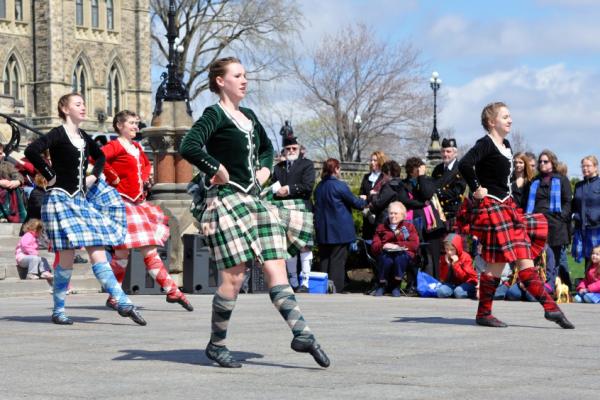 |
| Highland dancers at a Tartan Day festival in Canada. |
I'll be honest: St Patrick's Day is probably my favorite day of the year. It's a day to celebrate and show off my heritage, without looking like a crazy person by doing so.
Or half my heritage, anyway. I'm half Scottish, too. And as I discussed at greater length here, while you do see pipe bands and kilts and even St Andrew's Society delegations in the parades on St Patrick's Day, it's really Ireland's holiday.
Fortunately for the Scots among us, there are actually several opportunities to show off our Scottishness. The most traditional is St Andrew's Day, 30 November, the feast day of Scotland's patron saint. Obviously, this is mainly a religious holiday, but enjoying a dram and wearing your kilt that day are definitely not frowned upon. Then there's Burns Night, 25 January, to honor one of Scotland's most popular poets, Robert Burns (1759-96). This is generally celebrated with whisky, haggis, and poetry recitals, but if that's not really your style, or it's just too cold for a kilt in January, there's National Tartan Day on 6 April.
What, exactly, is Tartan Day, you ask? It's actually quite a recent creation, only officially celebrated in the US since 1998 and Canada since 1993. The date, 6 April, was chosen in commemoration of the Declaration of Arbroath (1320, during the reign of Robert the Bruce), in which the Scots asserted their national sovereignty in defiance of English territorial claims. Of course, I can't help but observe at this point that 6April is generally a very nice day to have an outdoor festival in most parts of the US, while Burns day and St Andrew's usually are not.
 |
| How many Scots do you see? |
To list every famous Scot would require several pages, but just to prove the point that these are people you can be proud to call your own, I'll say that in the last few centuries, Scots have fought for religious freedom, promoted democracy in Europe and North America, defined the concept of free-market economics, written dozens of classic novels and poems, made many scientific advances, including the invention of the telephone, fought bravely for Britain and for their various adoptive homes around the world, been active in politics, been pop culture icons as actors and musicians, and did I mention landing on the bloody moon?! Seriously, I'd say they deserve some recognition, wouldn't you?
So how does one celebrate Tartan Day?
Well, as this is a holiday established in the 1990's, there really aren't established traditions. Wearing tartan would seem the most obvious choice, though, and there are Tartan Day festivals around the country with pipe bands, highland dancers, historical re-enactors and so forth. Sadly, there aren't really a lot of Scottish pubs in most US cities (as far as I'm aware, anyway), but getting together a large group of people in kilts and invading your local English pub might be amusing, though the local Irish bar might be a little more welcoming. Or you can take advantage of the lovely April weather we'll hopefully have that day and enjoy some smoked salmon sandwiches and whisky outside (somewhere legal, obviously).
So which tartan should I wear?
| MacDonald of the Isles- my clan's tartan. |
Because so much of the Scottish immigration to the new world took place after the collapse of the clan system following defeat at the Battle of Culloden in 1746, but before the Celtic cultural revival of the late 19th century, many Scottish Americans don't know which clan they belong to. With most of the Jacobite chiefs dead or imprisoned after Culloden, there was no one to whom clansmen owed loyalty, and no Laird to rule the clans, so they simply disintegrated, and membership lost its significance. To make matters worse, Scots were one of America's first major immigrant groups, so immigration records are difficult to find.
Fortunately, the magic of the Internet does make it possible to find out with reasonable accuracy which clan you belong to. I'd still suggest starting with your family, though. Older family members are likely to know more about the family history than you do, even if you don't think they're actually interested. They're at least likely to know your great-grandmother's maiden name, and possibly even more. If your parents and grandparents are interested in your heritage, it's likely that someone's done at least a family tree at some point.
| Stewart Black tartan, my favorite of the universal tartans. |
Once you've found your clan (or clans), all that remains is to head over to the Scottish Tartans Authority or Scotweb to find your tartan and, if so inclined, get a kilt in it.
| Isle of Skye |
So remember to wear your tartan, or at least St. Andrew's blue, on the 6th, and take advantage of the other American Celtic holiday! The Colorado Tartan Day festival isn't until the 11th-12th, but events elsewhere across the country kick off this weekend, so look for a fun way to celebrate in your area, where there's hopefully lovely spring weather. Happy Tartan Day!
No comments:
Post a Comment